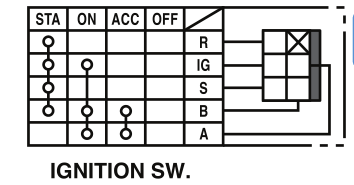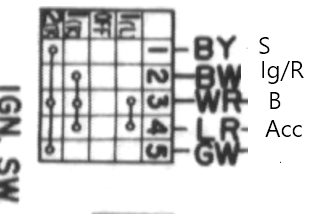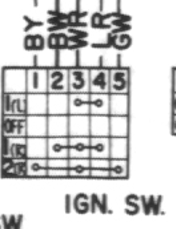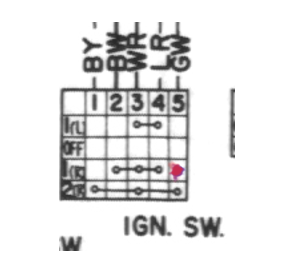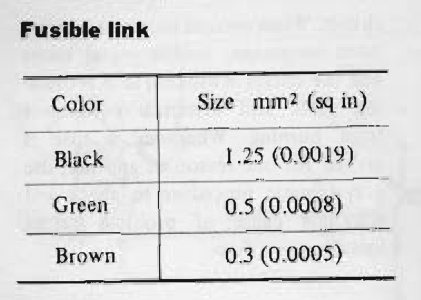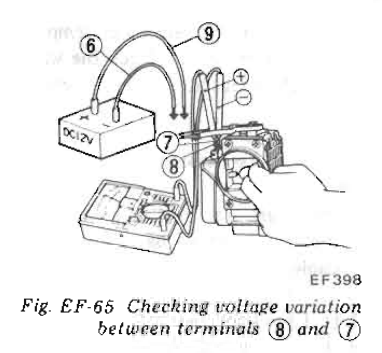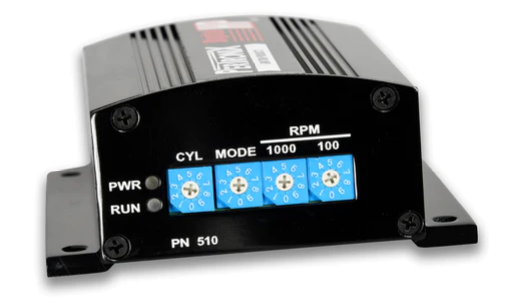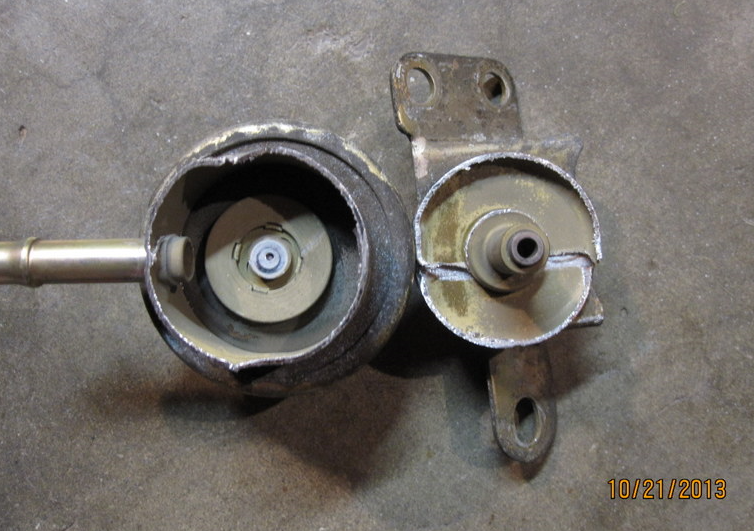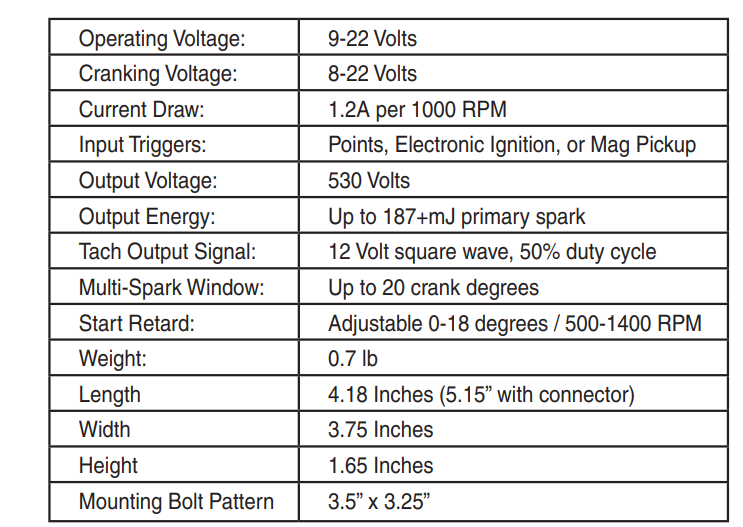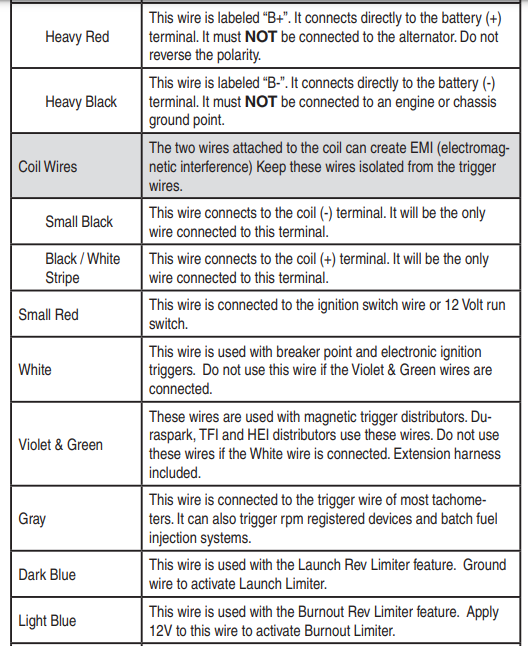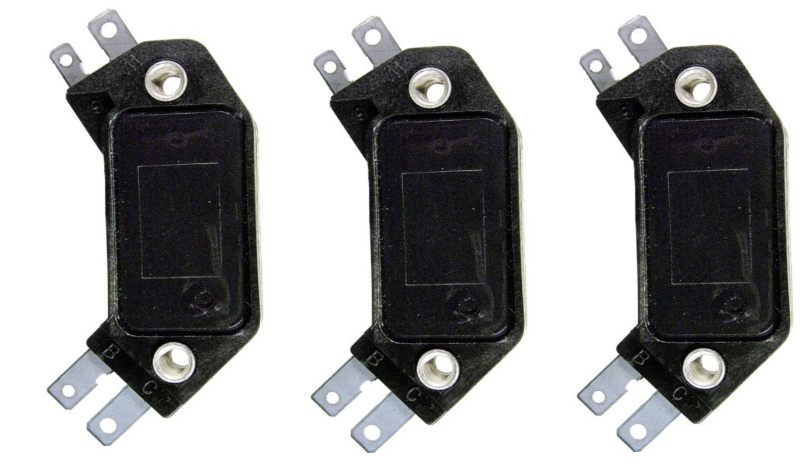Everything posted by Zed Head
-
Headlight switch problem- 1978 280z
My post about the relay was meant only about taking the load off of the power supply switch, which has the plastic nubbin melting problem, and the solder joint breaking problem (which the new brass piece won't fix. It will still get hot). I haven't seen any overheating problems described at the dimmer switch, which is where high and low are separated. Zs-ondabrains setup had relays on both ends, I thought. Might be worthwhile to go back and look at his work.
- Duffy's 1/71 Series 1 240z build
-
Duffy's 1/71 Series 1 240z build
Here's something funny though. This number is for a later model switch. Not a 240Z switch. So, G/W and B/W are already connected at Start (I assume, like the 280Z switch chart). Maybe just getting a 280Z switch will solve the problem. Time to plug it in and see what happens. https://www.rockauto.com/en/partsearch/?partnum=48750-e7705 https://www.classiczcars.com/forums/topic/58568-duffys-171-series-1-240z-build/?page=36#comment-644653
-
Duffy's 1/71 Series 1 240z build
Well, overall, I think the good news is that the problem has been defined and several solutions have been offered. The reason for the power loss seems clear and it should definitely be possible to remove that problem. I'd just try SteveJ's solution at the ballast resistor first. It's simple and it will most likely work, proving the circuit, then you can decide if you want to go farther. I learned something about the Nissan ignition switch illustrations. I need to go out and see how they do them today.
-
Duffy's 1/71 Series 1 240z build
Earlier I said that the Accessory pin would be powered if you did that. I think that I misunderstood how the switch works on the inside. The diagram is misleading. It looks like a circuit illustration but really it just shows what's connected to Battery at any position of the switch. Sorry about the confusion. If column #4 was connected to column #2 you would not be able to use Accessory alone, without having power to the the Ignition circuit. Therefore they must not be connected. Is there an effort here to keep the original wires intact? Seems odd to have powered wires run all the way in to the engine bay that don't actually serve their original purpose. I think that you could connect the pins on the back of the switch and achieve the same result as connecting them in the engine bay. A simple back probed jumper at the connection.
-
Duffy's 1/71 Series 1 240z build
Here is a 1976 280Z. 240Z next to it. Ig and R ((R)esistor/ballast) both get power on a 280Z switch. I'd test that switch's Ig and R pins and see what kind of switch you have. See if Ig and R both have continuity at Start. I thought this was a simple problem but it's really not. Maybe that's why they changed the switch, and the wiring.
-
Duffy's 1/71 Series 1 240z build
I picked the S circuit just because it was the first thing that came to mind. Wrong, pretty sure, the stuff below. Corrected farther down the page. If you connect GW and BW then you'll be backfeeding the Acc circuit during Start. #4. IF it's a 240Z switch. Check out the 1976 280Z switch in the next post.
-
Duffy's 1/71 Series 1 240z build
I think that you're back to the original point of your quest. You have a new switch now and you know how it functions. "Best" is very subjective. I think that the "key" point here is that you have the possibility of continuous power from the ignition switch from On to Start and back to On.
-
Duffy's 1/71 Series 1 240z build
That seems to answer the "bump" question, that would be the bridging point inside the switch. Seems like you could run a wire from the Start circuit to the ECU power supply and it would work. Probably need a diode so that you don't backfeed the Starter circuit through the On position. Similar to the 240Z alternator swap problem. You could also just add a separate power circuit for the ECU, with a switch or button. Might be good theft protection also. Or does this go all the way back to the original power supply wire problem? The overloaded wire. SteveJ's solutions. Anyway, there are several solution possibilities. Relays are your friend when you're adding new loads.
- Duffy's 1/71 Series 1 240z build
-
EFI Fusible Link Amperage
-
Strange intake noise?
You posted in the 1975 "strange intake noise" thread. I used the 1975 FSM. Still - wrong test method. There is no method for measuring resistance across the vane sweep.
-
Strange intake noise?
You have the wrong picture with the test method. The picture is for a single resistance measurement, not vane movement. Here is the correct picture. Terminals 7 and 8. And you're looking for smoothness of the voltage reading, not resistance. Page EF-51 and 52. p.s. you should not sand the carbon trace. It's not very thick, you could ruin it.
-
Master cylinder bench bleed
Looks used. Are you trying to find out if it's good? The larger bore will actually create less pressure. It's bigger because the ZX's had rear discs.
-
77 280z Restoration
My comment about capping the blue wire in the engine bay wasn't right. You need it on the coil. So you'd just cut the tach branch off of it and use the branch for the trigger wire. Seems like all of the needed wires are almost ready to go. It will all make sense once it's in hand. Looks like SteveJ is trying to get to plug and play, with connectors and all. I'd probably just set up a terminal strip. Anyway, don't forget to position it so you can see the adjustments. Good luck.
-
77 280z Restoration
That seems right. You'd have to guess that they were aware of the tach problems with the MSD boxes and engineered a "tach adapter" right in to the system. Looks like the same signal that the old ignition module would deliver. On-off-on-off...12 volts. The blue wire is branched at the ignition module. You might be able to just attach the old ignition module blue wire at the Pertronix box, since it's there, (Edited >and cap the blue wire end in the engine bay.) Not clear if the 2200 ohm resistor is needed. Probably won't hurt, it's good insurance against shorts. Stuff to think about.
-
FPR project - cheaper, more available (for a while anyway)
Here's the Walmart version. Herko. Never heard of them. Actually doesn't look bad. https://www.walmart.com/ip/Herko-Fuel-Pressure-Regulator-PR4082-For-Renault-Fiat-Alfa-Romeo-78-89-2-5-Bar/855274203 https://herko.com/
-
FPR project - cheaper, more available (for a while anyway)
Here's another option that only requires some hose adapters. No luck on Rockauto though. Spendy. https://www.blackvlvparts.com/product/bosch-fuel-pressure-regulator-2-5-bar-7564131/
-
FPR project - cheaper, more available (for a while anyway)
I got reinterested in a thought I've had before about finding a way to use a more available FPR on the 280Z fuel rails, since the stock PFR's are becoming scarce. I just looked on Rockauto and they don't even list FPR's as an option, not even an out-of-stock listing. https://www.rockauto.com/en/catalog/nissan,1978,280z,2.8l+l6,1209260,fuel+&+air I browsed around Rockauto and realized that the 2.5 bar (36.3 psi) pressure spec. was only around for a few years. Then they went to 3.0 bar, or some odd spec like Ford used of 2.7 bar (why Ford, why?). But I found a Bosch listing and cross-ref'ed it to Rockauto. I don't have my tools available or I might try to build something but it looks pretty easy. A small block of aluminum with a few holes in it should work, I think. Just posting in case somebody wants to try it. It might even be worth producing for sale. Here is the trail I followed. https://electromotive.com/our-products/2-5-bar-rail-mount-fuel-pressure-regulator/ The Bosch number - https://www.ebay.com/itm/275118121382 Rockauto using the Bosch number - https://www.rockauto.com/en/partsearch/?partnum=0280160225
-
Dropping Overnight Fuel Pressure
I don't know how it could be cleaned. I think you'd need a new one. Or a good used one. Here's a picture I took of one that I tore apart. The fuel comes in from the side port and forces the valve open to exit down the hole in the middle of the center tube on the right. You can see the wear marks on the seat where the exit port tube seals.
-
Dropping Overnight Fuel Pressure
Probably the fuel pressure regulator (FPR). The valve seats are just flat pieces of steel. Any rust or small particles can hang them open a bit. I tested quite a few used ones when I had quite a few and most of them leaked down. Took some trying to find one that didn't. If the return line is still pliable you can clamp it and see if it holds.
-
77 280z Restoration
It looks a lot like the MSD box. The wire colors are even similar. Makes a person wonder. Who knows. Should be fun. It does multi-spark which should help idle smoothness. Good luck. https://cdn.shopify.com/s/files/1/0247/6913/4628/files/512.pdf
-
77 280z Restoration
I I was starting over I'd probably mount three AC Delco modules in the old ignition box and wire them up with a switch that allowed me to change from one to another. AC Delco is OEM for the time I believe. More expensive too, $36 versus $21, although that could just be name recognition. The Pertronix box looks interesting though. https://www.rockauto.com/en/catalog/chevrolet,1977,camaro,5.0l+305cid+v8,1035111,ignition,ignition+control+module+(icm),7172 https://www.acdelco.com/
-
77 280z Restoration
The problem is the American owners ripping off their American customers. Not the people who make the product. The owners love it when people bash "China". It's their cover. They just keep raking in the easy money while everyone complains. The owners are the ones that set the low standards and accept the low quality product to pass on to the disappointed consumer. Anyway, you'd hope that a company introducing a new product would put the effort in to using the best design elements. But I wouldn't be surprised if there was just a tiny ignition module inside that big shiny Pertronix box. Probably assembled in America but the parts made elsewhere. Sorry, it's just today's reality. If I was looking for reliability I'd try to adapt a system from a modern car. Today's cars are designed for low maintenance and low emissions. They can't have ignition systems failing. Most cars have computer controlled ignition but I wonder if some don't have the older style still. I tried to find an OEM GM HEI module but it looks like they're all aftermarket now.
-
saturday night music thread




